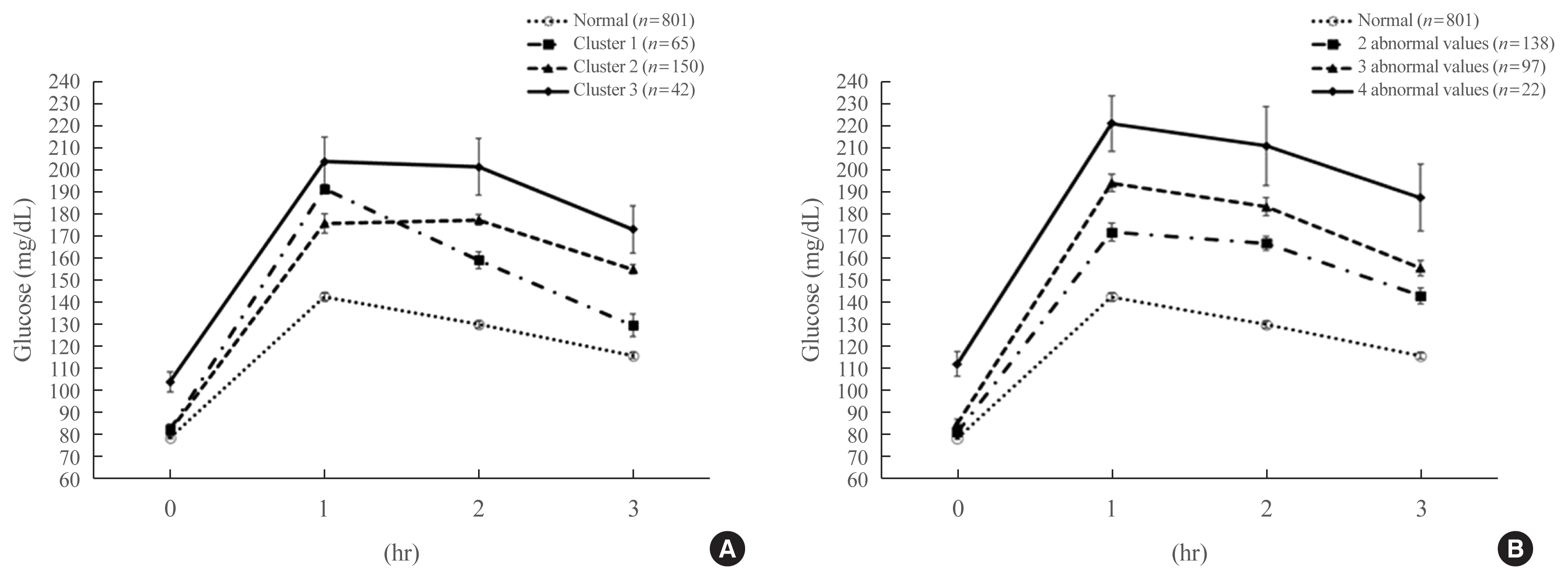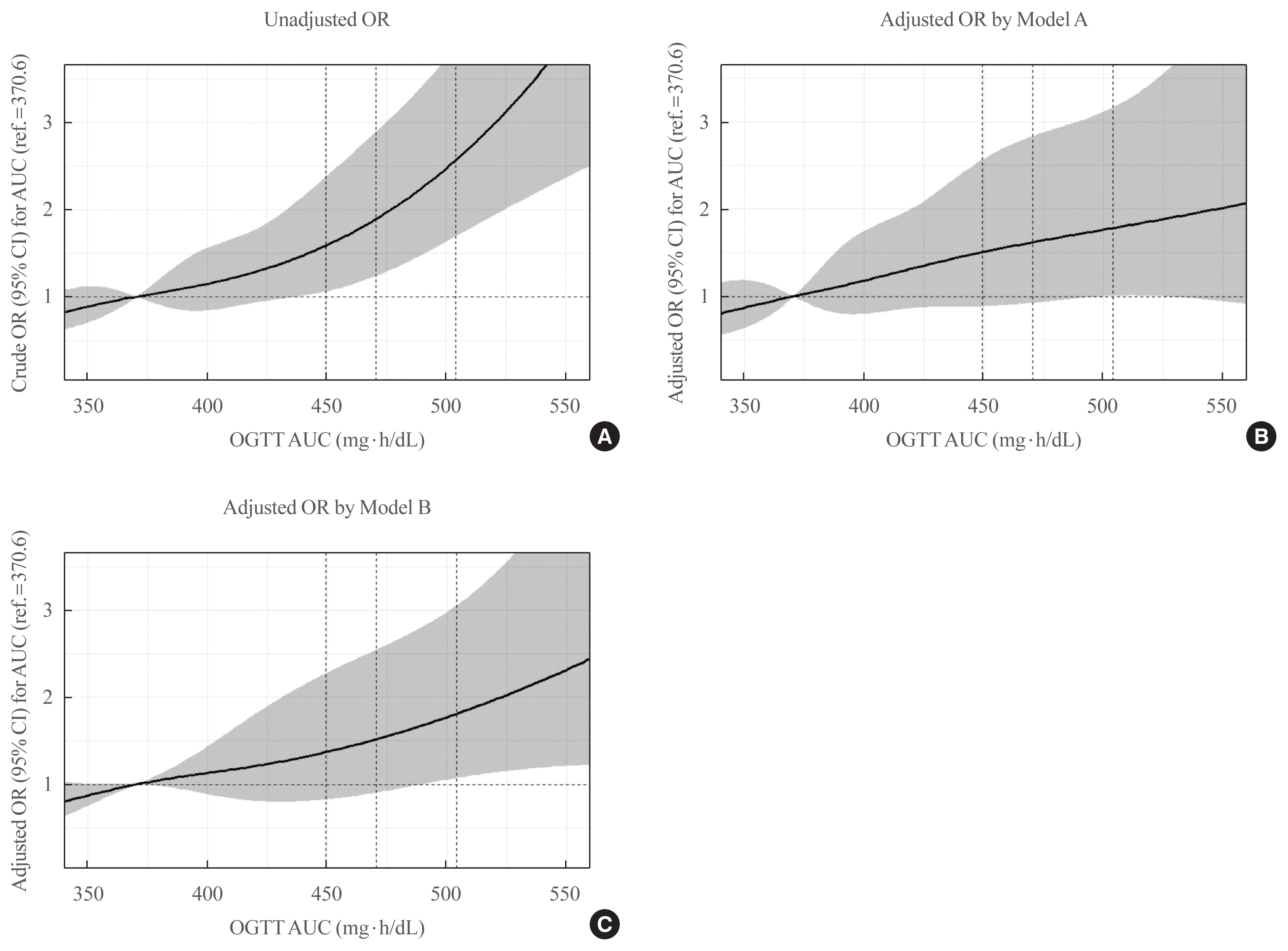Abstract
Background
Methods
Results
ACKNOWLEDGMENTS
SUPPLEMENTARY INFORMATION
Supplemental Table S1.
Supplemental Table S2.
Supplemental Table S3.
Supplemental Table S4.
REFERENCES
Fig. 1

Fig. 2

Table 1
GDM, gestational diabetes mellitus; BMI, body mass index; HTN, hypertension; DM, diabetes mellitus; OGTT, oral glucose tolerance test; HbA1c, glycosylated hemoglobin; HOMA-IR, homeostatic model assessment of insulin resistance; HOMA-β, homeostatic model assessment of β cell; SBP, systolic blood pressure; DBP, diastolic blood pressure; FBG, fasting blood glucose; TC, total cholesterol; TG, triglyceride; HDL-C, high-density lipoprotein cholesterol.
Table 2
| No. of events, no./total (%) | Unadjusted model | P value | Model 1a | P value | Model 2b | P value | |
|---|---|---|---|---|---|---|---|
| Normal | 124/801 (15.5) | 1 (Reference) | 1 (Reference) | 1 (Reference) | |||
|
|
|||||||
| GDM | |||||||
| Cluster 1 | 16/65 (24.6) | 1.78 (0.98–3.24) | 0.057 | 1.58 (0.80–3.10) | 0.189 | 1.57 (0.72–3.45) | 0.260 |
| Cluster 2 | 38/150 (25.3) | 1.85 (1.22–2.81) | 0.004 | 1.54 (0.97–2.45) | 0.071 | 1.59 (0.93–2.74) | 0.091 |
| Cluster 3 | 19/42 (45.2) | 4.51 (2.39–8.53) | <0.001 | 2.97 (1.45–6.09) | 0.003 | 2.10 (0.87–5.08) | 0.100 |
|
|
|||||||
| P for trend test | <0.001 | 0.002 | 0.002 | ||||
a Adjusted for age, preexisting hypertension, family history of diabetes mellitus, family history of hypertension, pre-pregnancy body mass index (BMI), parity (yes or no), and gestational age (before delivery);
b Adjusted for age, preexisting hypertension, family history of diabetes mellitus, family history of hypertension, pre-pregnancy BMI, parity (yes or no), gestational age (before delivery), systolic blood pressure at 35 weeks of gestation, diastolic blood pressure at 35 weeks of gestation, fasting blood glucose at 35 weeks of gestation, and insulin treatment.
Table 3
| No. of events, no./total (%) | Unadjusted Model | P value | Model 1a | P value | Model 2b | P value | |
|---|---|---|---|---|---|---|---|
| Normal | 124/801 (15.5) | 1 (Reference) | 1 (Reference) | 1 (Reference) | |||
|
|
|||||||
| No. of abnormal values | |||||||
| 2 | 29/138 (21.0) | 1.45 (0.92–2.28) | 0.106 | 1.25 (0.76–2.06) | 0.385 | 1.27 (0.72–2.23) | 0.414 |
| 3 | 31/97 (32.0) | 2.56 (1.61–4.09) | <0.001 | 2.20 (1.30–3.74) | 0.003 | 2.16 (1.21–3.85) | 0.009 |
| 4 | 13/22 (59.1) | 7.89 (3.30–18.85) | <0.001 | 4.03 (1.51–10.79) | 0.006 | 2.32 (0.66–8.15) | 0.188 |
|
|
|||||||
| P for trend test | <0.001 | <0.001 | 0.011 | ||||
a Adjusted for age, preexisting hypertension, family history of diabetes mellitus, family history of hypertension, pre-pregnancy body mass index (BMI), parity (yes or no), and gestational age (before delivery);
b Adjusted for age, preexisting hypertension, family history of diabetes mellitus, family history of hypertension, pre-pregnancy BMI, parity (yes or no), gestational age (before delivery), systolic blood pressure at 35 weeks of gestation, diastolic blood pressure at 35 weeks of gestation, fasting blood glucose at 35 weeks of gestation, and insulin treatment.
Table 4
| No. of events, no./total (%) | Unadjusted model | P value | Model 1a | P value | Model 2b | P value | |
|---|---|---|---|---|---|---|---|
| Normal | 124/801 (15.5) | 1 (Reference) | 1 (Reference) | 1 (Reference) | |||
|
|
|||||||
| AUC quartile (min–max) | |||||||
| Q1 (364.5–449.0) | 12/64 (18.8) | 1.26 (0.65–2.43) | 0.490 | 1.14 (0.56–2.34) | 0.720 | 1.00 (0.43–2.29) | 0.995 |
| Q2 (449.5–470.0) | 12/65 (18.5) | 1.24 (0.64–2.38) | 0.526 | 1.02 (0.49–2.11) | 0.954 | 1.63 (0.73–3.66) | 0.233 |
| Q3 (470.5–503.5) | 21/65 (32.3) | 2.61 (1.50–4.53) | 0.001 | 2.34 (1.25–4.37) | 0.008 | 2.03 (0.98–4.21) | 0.057 |
| Q4 (504.0–727.0) | 28/63 (44.4) | 4.37 (2.56–7.44) | <0.001 | 2.84 (1.55–5.18) | 0.001 | 2.31 (1.09–4.91) | 0.030 |
|
|
|||||||
| P for trend test | <0.001 | <0.001 | 0.007 | ||||
a Adjusted for age, preexisting hypertension, family history of diabetes mellitus, family history of hypertension, pre-pregnancy body mass index (BMI), parity (yes or no), and gestational age (before delivery);
b Adjusted for age, preexisting hypertension, family history of diabetes mellitus, family history of hypertension, pre-pregnancy BMI, parity (yes or no), gestational age (before delivery), systolic blood pressure at 35 weeks of gestation, diastolic blood pressure at 35 weeks of gestation, fasting blood glucose at 35 weeks of gestation, and insulin treatment.




 PDF
PDF Citation
Citation Print
Print



 XML Download
XML Download